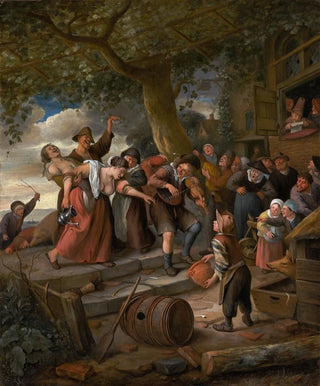Art print | A pig belongs to the pigsty - Jan Steen


View from behind

Frame (optional)
In the vibrant universe of 17th-century Dutch painting, Jan Steen's "A pig belongs to the pigsty" stands out for its humor and liveliness. This canvas, imbued with realism, immerses us in daily life in the Netherlands at a time when the genre of genre painting asserts itself strongly. Steen, master of pictorial storytelling, invites us to explore a scene where human nature is displayed in all its complexity, oscillating between joy and disorder. Through this art print, the viewer is transported to a world where social interactions and customs of the time are subtly highlighted, offering a reflection on the human condition.
Style and uniqueness of the work
Jan Steen's style is characterized by a palette of vibrant colors and meticulous attention to detail. In "A pig belongs to the pigsty," the artist uses light and shadow to emphasize the expressions of the characters, making each face and gesture strikingly expressive. This painting, far from being a simple depiction of rural life, transforms into a narrative scene where each element contributes to a larger story. The characters, caught in a moment of conviviality, are surrounded by everyday objects that add an extra dimension to the composition. The pig, emblem of the pigsty, here becomes a symbol of human nature, both comic and tragic, revealing the flaws and pleasures of life.
The artist and his influence
Jan Steen, born in 1626 in Leiden, is often considered one of the greatest masters of genre painting. His ability to capture moments of daily life with such emotional intensity has left an indelible mark on art history. Steen does not merely depict mundane scenes; he elevates them to works of art by injecting a dose of irony and satire. His influence extends beyond his era, inspiring many later artists who sought to explore the nuances of human life through humor and social critique. By observing "A pig belongs to the pigsty,"

Matte finish

View from behind

Frame (optional)
In the vibrant universe of 17th-century Dutch painting, Jan Steen's "A pig belongs to the pigsty" stands out for its humor and liveliness. This canvas, imbued with realism, immerses us in daily life in the Netherlands at a time when the genre of genre painting asserts itself strongly. Steen, master of pictorial storytelling, invites us to explore a scene where human nature is displayed in all its complexity, oscillating between joy and disorder. Through this art print, the viewer is transported to a world where social interactions and customs of the time are subtly highlighted, offering a reflection on the human condition.
Style and uniqueness of the work
Jan Steen's style is characterized by a palette of vibrant colors and meticulous attention to detail. In "A pig belongs to the pigsty," the artist uses light and shadow to emphasize the expressions of the characters, making each face and gesture strikingly expressive. This painting, far from being a simple depiction of rural life, transforms into a narrative scene where each element contributes to a larger story. The characters, caught in a moment of conviviality, are surrounded by everyday objects that add an extra dimension to the composition. The pig, emblem of the pigsty, here becomes a symbol of human nature, both comic and tragic, revealing the flaws and pleasures of life.
The artist and his influence
Jan Steen, born in 1626 in Leiden, is often considered one of the greatest masters of genre painting. His ability to capture moments of daily life with such emotional intensity has left an indelible mark on art history. Steen does not merely depict mundane scenes; he elevates them to works of art by injecting a dose of irony and satire. His influence extends beyond his era, inspiring many later artists who sought to explore the nuances of human life through humor and social critique. By observing "A pig belongs to the pigsty,"






